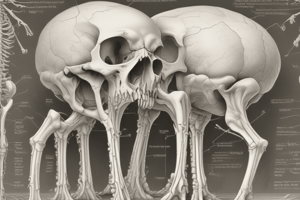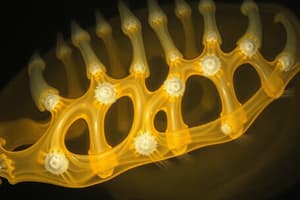Podcast
Questions and Answers
All types of cartilage are surrounded by perichondrium.
All types of cartilage are surrounded by perichondrium.
False
The primary function of bones is to act solely as a framework for muscles.
The primary function of bones is to act solely as a framework for muscles.
False
Fibrocartilage contains large bundles of collagen and is designed to resist both compression and tension forces.
Fibrocartilage contains large bundles of collagen and is designed to resist both compression and tension forces.
True
The axial skeleton includes bones that are primarily involved in locomotion.
The axial skeleton includes bones that are primarily involved in locomotion.
Signup and view all the answers
Hyaline cartilage is the most common type and is found in most joints.
Hyaline cartilage is the most common type and is found in most joints.
Signup and view all the answers
Chondrocytes are the cells found within the lacunae of bone tissue.
Chondrocytes are the cells found within the lacunae of bone tissue.
Signup and view all the answers
Compact bone and spongy bone have distinct microscopic structures.
Compact bone and spongy bone have distinct microscopic structures.
Signup and view all the answers
Muscles pull against the skeleton to facilitate movement such as sitting, walking, and running.
Muscles pull against the skeleton to facilitate movement such as sitting, walking, and running.
Signup and view all the answers
Osteoclasts are responsible for building new bone.
Osteoclasts are responsible for building new bone.
Signup and view all the answers
Endochondral ossification occurs in the deeper layers of the dermis.
Endochondral ossification occurs in the deeper layers of the dermis.
Signup and view all the answers
Chondrocytes die when the matrix has calcified during bone growth.
Chondrocytes die when the matrix has calcified during bone growth.
Signup and view all the answers
Flat bones of the skull are formed through endochondral ossification.
Flat bones of the skull are formed through endochondral ossification.
Signup and view all the answers
Epiphyseal plates are responsible for the growth in the thickness of bones.
Epiphyseal plates are responsible for the growth in the thickness of bones.
Signup and view all the answers
The medial part of the clavicle is an example of a bone formed by intramembranous ossification.
The medial part of the clavicle is an example of a bone formed by intramembranous ossification.
Signup and view all the answers
Chondrocytes divide and form columns on the diaphyseal side of the epiphyseal plate.
Chondrocytes divide and form columns on the diaphyseal side of the epiphyseal plate.
Signup and view all the answers
During bone thickness growth, ridges around blood vessels fuse to form a canal.
During bone thickness growth, ridges around blood vessels fuse to form a canal.
Signup and view all the answers
Bones are primarily made up of connective tissue, epithelial tissue, and nervous tissue.
Bones are primarily made up of connective tissue, epithelial tissue, and nervous tissue.
Signup and view all the answers
The main function of bones is to provide energy metabolism.
The main function of bones is to provide energy metabolism.
Signup and view all the answers
Flat bones are characterized by an elongated shape, such as those found in the limbs.
Flat bones are characterized by an elongated shape, such as those found in the limbs.
Signup and view all the answers
Sesamoid bones are generally found within tendons and include the patella.
Sesamoid bones are generally found within tendons and include the patella.
Signup and view all the answers
Pneumatized bones are solid and do not contain air pockets.
Pneumatized bones are solid and do not contain air pockets.
Signup and view all the answers
Irregular bones, such as the vertebrae, have a uniform shape.
Irregular bones, such as the vertebrae, have a uniform shape.
Signup and view all the answers
The primary role of the skull is to facilitate locomotion.
The primary role of the skull is to facilitate locomotion.
Signup and view all the answers
Osteocalcin, produced by osteoblasts, affects bone production and insulin stimulation.
Osteocalcin, produced by osteoblasts, affects bone production and insulin stimulation.
Signup and view all the answers
The femur and tibia are critical for skeletal mobility.
The femur and tibia are critical for skeletal mobility.
Signup and view all the answers
Short bones have a central marrow cavity.
Short bones have a central marrow cavity.
Signup and view all the answers
The matrix of bone tissue consists of 15% water, 30% collagen fibers, and 55% minerals.
The matrix of bone tissue consists of 15% water, 30% collagen fibers, and 55% minerals.
Signup and view all the answers
Osteoclasts are responsible for bone formation and growth.
Osteoclasts are responsible for bone formation and growth.
Signup and view all the answers
Osteocytes are the main cells responsible for the maintenance and metabolism of healthy bone.
Osteocytes are the main cells responsible for the maintenance and metabolism of healthy bone.
Signup and view all the answers
Trabeculae in spongy bone are arranged randomly and do not respond to stress.
Trabeculae in spongy bone are arranged randomly and do not respond to stress.
Signup and view all the answers
The periosteum is made up of a fibrous layer and a cellular layer containing osteoprogenitor cells.
The periosteum is made up of a fibrous layer and a cellular layer containing osteoprogenitor cells.
Signup and view all the answers
Compact bone does not contain osteons or Haversian systems.
Compact bone does not contain osteons or Haversian systems.
Signup and view all the answers
The periosteum is present in sesamoid bones.
The periosteum is present in sesamoid bones.
Signup and view all the answers
The endosteum is a single layer of osteoprogenitor cells that is always continuous.
The endosteum is a single layer of osteoprogenitor cells that is always continuous.
Signup and view all the answers
The nutrient foramen can be found in the diaphysis of long bones.
The nutrient foramen can be found in the diaphysis of long bones.
Signup and view all the answers
Compact bone is thicker where mechanical forces are lesser.
Compact bone is thicker where mechanical forces are lesser.
Signup and view all the answers
Spongy bone is more appropriate for unidirectional tension.
Spongy bone is more appropriate for unidirectional tension.
Signup and view all the answers
Surface markings on bones allow attachment points for muscles, tendons, and ligaments.
Surface markings on bones allow attachment points for muscles, tendons, and ligaments.
Signup and view all the answers
The neural supply within the periosteum consists of sensory nerves that contribute to pain perception in fractures.
The neural supply within the periosteum consists of sensory nerves that contribute to pain perception in fractures.
Signup and view all the answers
All bone markings necessary for the passage of nerves and blood vessels are formed after birth.
All bone markings necessary for the passage of nerves and blood vessels are formed after birth.
Signup and view all the answers
Study Notes
Bone Formation
- Endochondral ossification is the process of bone formation from a cartilage model.
- Intramembranous ossification is the process of bone formation directly from mesenchyme or fibrous connective tissue.
- Osteoblasts are cells that produce bone matrix and are responsible for bone formation.
- Osteoclasts are cells that breakdown bone and are responsible for bone resorption.
- Chondrocytes are cells that produce cartilage matrix.
- Mesenchymal cells are undifferentiated cells that can develop into a variety of cell types.
- Intramembranous ossification occurs in the deeper layers of the dermis and results in dermal bones such as the flat bones of the skull, facial bones, mandible, and medial part of the clavicle.
Bone Growth
- Bone length increases at the epiphyseal plate.
- Zone 1 anchors the epiphyseal plate to the epiphysis.
- Zone 2 is where chondrocytes divide and form columns.
- Zone 3 is where chondrocytes enlarge and start producing a calcified matrix.
- Zone 4 is where chondrocytes die because the matrix has calcified.
- Zone 5 is where osteoclasts dissolve the calcified cartilage and osteoblasts and blood vessels invade the area to form new bone.
- Bone growth stops when the epiphyseal plate becomes ossified after adolescence.
- Bone thickness increases by the periosteum where cells differentiate into osteoblasts and produce bone matrix.
- Endosteum is formed by the periosteum as the bone grows in thickness and forms new bone on the inner side of the bony wall.
Skeletal System
- Bones are considered organs with multiple tissue types including connective tissue, epithelial tissue, nervous tissue and blood tissue.
- Skeleton is the framework of the body, composed of cartilage and bone.
- Axial Skeleton includes the skull, vertebral column, ribs and sternum.
- Appendicular Skeleton includes the bones of the limbs, pectoral and pelvic girdles
- Cartilage is composed of collagen and/or elastic fibers and chondrocytes in lacunae (cavities) surrounded by perichondrium.
- Hyaline cartilage is the most common type and has a fine fiber matrix.
- Fibrocartilage has large bundles of collagen fibers and is found in areas that resist compression and tension forces, such as the intervertebral discs
- Elastic cartilage has a larger proportion of elastic fibers in the matrix and is found in areas that need flexibility such as the epiglottis.
Functions of Bones
- Support by providing framework to support body weight and soft tissue.
- Movement by providing levers for the muscles to produce movement.
- Protection by protecting vital organs such as the brain, spinal cord, heart, and lungs.
- Mineral Storage by storing calcium and phosphate.
- Blood cell production by producing red and white blood cells in the red bone marrow (hematopoiesis).
- Energy storage by storing fat in the yellow bone marrow.
- Energy metabolism by producing the hormone osteocalcin which influences bone production, fat storage, and insulin production.
Bone Classification
- Long bones are elongated bones with epiphyses, metaphyses and a diaphysis.
- Flat bones are thin, flattened bones with two layers of compact bone surrounding a layer of spongy bone.
- Short bones are cube-shaped bones.
- Sesamoid bones are small, round bones found within tendons, such as the patella.
- Irregular bones have a complex shape and varied functions, such as the vertebrae.
- Sutural bones are small, irregular bones found in the sutures of the skull.
- Pneumatized bones are hollow bones or bones with air pockets, such as the ethmoid bone.
Bone Anatomy
- Long bones have a diaphysis (shaft) and epiphyses (ends).
- Compact bone forms the outer layer of the diaphysis and inside the epiphyses.
- Spongy or cancellous bone is found in the interior of the epiphyses.
- Marrow cavity is a space that houses bone marrow.
- Periosteum is a tough, fibrous membrane that covers the outer surface of bones.
- Endosteum is a thin membrane that lines the medullary cavity and the canals that contain blood vessels.
- Articular cartilage is a thin layer of hyaline cartilage that covers the ends of bones where they articulate with other bones.
Microscopic structure of bone
- Compact bone is made of osteons (Haversian systems) and lamellae.
- Osteons are cylindrical units that contain osteocytes, concentric lamellae, a central canal, canaliculi, and Volkmann's canals.
- Lamellae are thin, concentric rings of bone matrix.
- Central canal is a hollow space that contains blood vessels and nerves.
- Canaliculi are thin channels that connect lacunae (small spaces that house osteocytes) to the central canal.
- Volkmann's canals are channels perpendicular to the Haversian canals that connect blood vessels and nerves to the periosteum and endosteum.
- Spongy bone is less dense than compact bone and has a lattice-like structure that contains trabeculae.
- Trabeculae are thin plates of bone that are arranged along lines of stress.
- Bone marrow fills the spaces between the trabeculae and may be red or yellow.
Bone Composition
- Matrix is composed of 15% water, 30% collagen fibers, and 55% mineral salts.
- Collagen fibers provide elasticity.
- Mineral salts provide rigidity.
- Osteogenic cells are undifferentiated bone cells that have the potential to develop into osteoblasts.
- Osteoblasts are bone-building cells that secrete bone matrix and become osteocytes.
- Osteocytes are mature bone cells that maintain and regulate bone metabolism.
- Osteoclasts are bone-resorbing cells.
- Bone remodeling is a continuous process of bone formation and resorption that helps regulate calcium levels in the blood.
Bone Forces
- Compact bone is thicker and more dense where forces are greater.
- Spongy bone is arranged in a network that is aligned to counteract stresses in multiple directions.
- Tension and compression forces constantly remodel the bone surface resulting in different markings throughout life.
Bone Markings
- Surface markings provide points of attachment for tendons and ligaments and are often not present at birth.
- Other markings allow the passage of nerves and blood vessels.
Blood and Nerve Supply
- Nutrient foramina are openings in the diaphysis of long bones that allow for the passage of blood vessels and nerves.
- Nutrient artery supplies the diaphysis.
- Nutrient vein drains the diaphysis.
- Perforating canals are channels in the periosteum that connect blood vessels to those in the central canals of the osteons.
- Sensory nerves are involved in pain perception when fractures occur.
Bone Healing
-
Bone fracture healing occurs in four stages:
- Hematoma formation: blood clot forms at fracture site
- Soft callus formation: fibrocartilaginous tissues form over the fracture
- Hard callus formation: bony spurs bridge the fracture gap
- Remodeling: hard callus is remodeled into compact bone.
Studying That Suits You
Use AI to generate personalized quizzes and flashcards to suit your learning preferences.
Related Documents
Description
This quiz covers key processes in bone formation including endochondral and intramembranous ossification. It highlights the roles of various cells such as osteoblasts, osteoclasts, and chondrocytes in the growth and development of bones. Test your knowledge on the cellular mechanisms and stages of bone growth.




